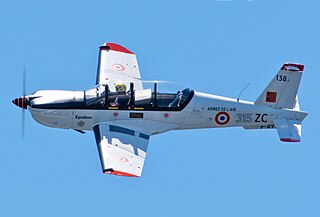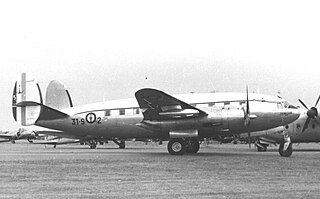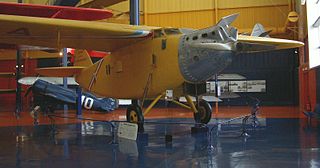
The Latécoère 28 was a successful French long-haul mail plane and passenger airliner of the 1930s. It was the main-stay of Air France's predecessor, Aéropostale, in its efforts to establish intercontinental air mail services and support French colonialism and French cultural influence between the wars.

The IAR 14 is a Romanian low-wing monoplane fighter-trainer aircraft designed before World War II.

The Dassault Super Mystère is a French supersonic fighter-bomber and was the first Western European supersonic aircraft to enter mass production.

The Socata TB 30 Epsilon is a light military trainer aircraft produced by SOCATA. It is a tandem two-seater with a metal airframe. The first prototype flew on 22 December 1979.

The Sud-Ouest S.O.30 Bretagne was a 1940s French airliner built by Sud-Ouest.

The Nord Aviation 3202 was a 1950s French military trainer aircraft designed and built by Nord Aviation to meet a French Army requirement for a two-seat basic trainer, as a replacement for the biplane Stampe SV.4. Altogether, 101 examples were built, with the first flying on 17 April 1957.
The Arsenal VB 10 was a French fighter-interceptor aircraft developed during and shortly after World War II. It was a low-wing monoplane with retractable tailwheel undercarriage and of largely orthodox configuration. The ultimate product of a design that began with the Arsenal VG 10 prior to the war, the VB 10 added a second engine behind the cockpit which drove a second propeller, coaxial with and contra-rotating to the propeller driven by the engine in the nose.

The Bernard 190 or Bernard-Hubert 190 was a French airliner of 1928. It was a high-wing cantilever monoplane of conventional configuration, based on the Bernard 18. Compared with its predecessor, it kept the same basic design but featured redesigned tail surfaces, an enlarged cabin, and offered its flight crew a completely enclosed cockpit. Also like its predecessor, the basic airliner model provided the basis for a long-range aircraft to be used in record attempts, the 191GR.
The THK-5 was a twin-engine aircraft designed by Stanisław Rogalski and built in Turkey in 1945 as an air ambulance. It was a conventional, low-wing cantilever monoplane of wooden construction throughout. The main units of the tailwheel undercarriage retracted into the wing-mounted engine nacelles and the THK-5 could carry two stretcher cases plus a medical attendant. This was followed in production by a six-seat utility transport version designated THK-5A and three examples of an improved version of the 5A designated THK-10. A single example of the type was exported, sold to Denmark.

The Potez IX was an early airliner produced in France in the 1920s, a further development of the SEA IV that Henry Potez had co-designed during the First World War.

The Potez 53 was a French low-wing enclosed cockpit single-seat cantilever monoplane racing aircraft built by Potez to specifically to compete in the 1933 Coupe Deutsch de la Meurthe race, which it won outright.

The Morane-Saulnier MS.755 Fleuret was a prototype French two-seat jet trainer designed and built by Morane-Saulnier. It failed to gain any orders but was developed into the larger four-seat MS.760 Paris.

The Fokker T.IX was a Dutch twin-engined bomber designed and built by Fokker for the Royal Netherlands East Indies Army Air Force as a replacement for their obsolescent Martin-built bombers.
The IAR 12 is a Romanian low-wing monoplane fighter-trainer aircraft designed before World War II.
The IAR 13 is a Romanian low-wing monoplane fighter-trainer aircraft designed before World War II.

The IAR 16 was a low-wing monoplane fighter designed in Romania in 1934.

The Potez-CAMS 160 was a one-off 5/13 scale flight model built in France, first flown in the summer of 1938 to test aerodynamic and hydrodynamic qualities of the Potez-CAMS 161 airliner and mail carrier, which was too large for detailed modelling in existing wind tunnels.

The Potez-CAMS 161 was a large, French six-engined flying boat airliner, designed to operate on the North Atlantic routes that were opening up in the late 1930s. Its development was almost halted by World War II. Just one was built and partially tested before its destruction by Allied forces near the war's end.

The SNCAC NC.1070 was a piston engined attack and torpedo bomber designed and built in France shortly after World War II. The second prototype, the NC1071, was the first French multi-jet turbine powered aircraft.
The Kellner-Béchereau E.60 was a prototype single-engine, single-seat training aircraft, designed in France in the late 1930s. It was a monoplane with a novel "double" wing, the rear part providing lift and lateral control as well as acting as slotted flaps.















